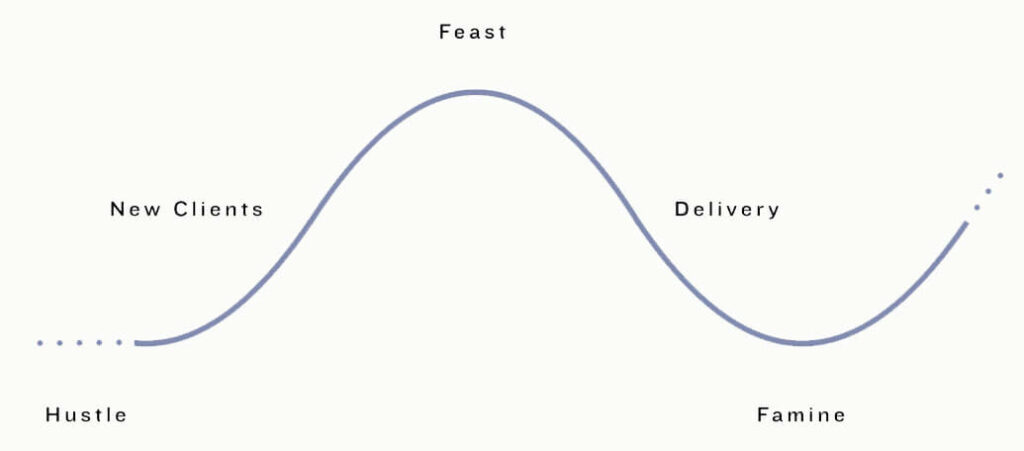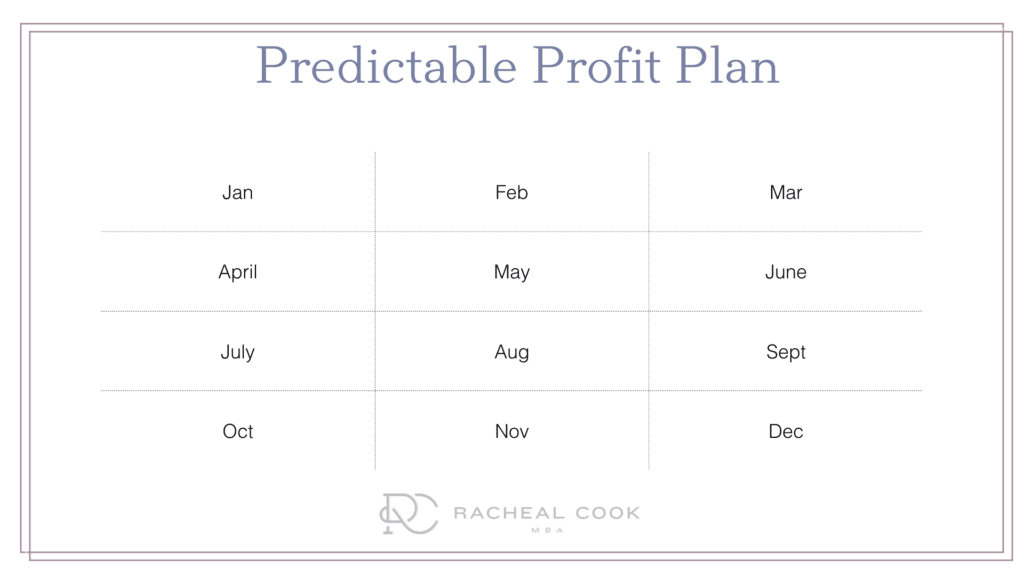$50,000.
75% of women entrepreneurs earn less than $50,000 a year in revenue.
That might be fine as a salary… but as an annual revenue for a business? By the time you pay your business expenses and taxes, then figure out how much you’re actually earning per hour, it’s easy to see why 80% of entrepreneurs give up after 18 months.
And for the 25% who do earn more than $50,000… only 12% break the six-figure mark in their business.
I learned these stats a few years ago when I was invited to go to Washington DC to speak on a panel at the US Chamber of Commerce about women in business.
When the panel was over, for the next two hours I talked with women who had tons of questions about how I was able to not only create my business, but create a business that 100% supported our lifestyle and even allowed my husband to retire from his teaching career to be at home with our family.
Answering questions from the women at this event started the inquiry – “What is keeping these women from breaking through from 5 to 6 figures?“
As I talked with more and more women, it became clear that the feast or famine cycle is one of the biggest reasons why their businesses simply stop growing, sometimes for years, and holds them back from creating a predictably profitable business.

The feast or famine cycle looks something like this:
- You start out doing the new client hustle. All your time and energy is going into marketing your business and talking to potential new clients.
- New clients sign up and you enter feast mode! Your client docket is filling up, revenue is coming in the door, people are paying you to do what you love! #WINNING
- You roll up your sleeves and get to work. Now that you have clients, you’ve gotta do the work they hired you for, right? Right!
- Your clients wrap up working with you, which means you slowly start running out of money (famine!) and the hustle starts all over again.
Many freelancers stay stuck in this cycle for years because of one BIG mistake: they stop marketing their business when they are in feast mode.
Which means when those existing clients wrap up after a few months, there isn’t anyone who has been waiting for the next available spot. In fact, some potential clients have moved on! The hustle starts again.
If you’re in the feast or famine cycle, it’s incredibly frustrating because you constantly feel like you’re starting from scratch, especially in those first few years when you are still working out all of your different income streams and the right times of the year to promote or launch your various products, programs, or services.
And it’s incredibly disheartening when you have the best month ever followed by one of the worst.
I have seen over and over again so many people celebrating finally achieving $5K, $10K, or even $15K months, but then they come back to me the following month saying,
“OMG, I barely made anything this month. I guess my average month is a lot lower than that best month ever.“
While the biggest reason many freelancers continue to repeat the feast or famine cycle in their business is due to lack of consistent marketing and sales strategy, more marketing isn’t always the answer.
There is often a bigger issue that will continue to hold them back from designing a predictably profitable business.
The business is trapped in the feast or famine zone.
This is where many businesses get trapped when they lack a strategy to properly price, package, and position their products and services.
What exactly is the feast or famine zone?
On one end of the spectrum (bottom left) are businesses that serve the masses at low prices. Businesses like Walmart or Amazon can afford to compete based on crazy low prices because of their sophisticated systems behind the scenes that reduce overhead costs in other areas of their business.
On the other side of the spectrum (top right) are businesses that serve a smaller audience at a higher price point. You can buy a white t-shirt at Walmart for $3 or spend $35 at Nordstrom. Why would you buy the shirt at Nordstrom? It’s going to have higher quality fit and fabric. Nordstrom can price a simple white t-shirt 10X higher because they know their clientele value, and will happily pay for, higher quality products.
So what is happening inside that feast or famine zone right in the middle?
When a business lacks the right strategy to price, package, and position its products and services, they end up struggling to compete because:
- Profit margins suffer. The biggest challenge with attempting to stay competitive with your prices is that you often set yourself up for price-shoppers. Potential clients aren’t coming to you because they love your work or value the end results you provide, they are coming to you because you are affordable. Don’t be the Walmart of your industry!
- There isn’t enough capacity. When you operate in this zone where you’re under-pricing your products, programs, or services, you have to max out your calendar with clients in order to generate a liveable income!
Here’s how that might look:
Let’s say you’re a wedding photographer with a goal of $50,000 in revenue in your business. (This is an example, friends! The numbers I’m about to talk about could vary dramatically based on location, experience, etc.)
You might start this photography business thinking you easily shoot 25 weddings a year for $2000 per wedding. Seems reasonable, right?
Then you quickly realize wedding happen in seasons, which means that to shoot 25 weddings a year doesn’t equal a wedding every two weeks all year long. It’s more like fast and furious wedding seasons where you might be shooting a wedding every single weekend for three to four months straight.
And for each eight hours of wedding day photography, there is another 12 hours of client management and 20 hours of editing photos. You’re not getting paid $250+ an hour for photography, it’s more like $50 an hour.
Then you add in your overhead expenses (like your website, marketing, and camera equipment) and freelance taxes, and suddenly you realize that your actual take-home pay is a lot less than what you hoped.
Not to mention you’ve gotta make sure that the revenue you’re generating during those fast-and-furious months actually stretches out during the slower months.
So how do you end the Feast or Famine cycle for good?
Step 1: Raise your prices
I know, I know. This is scary!
But after coaching thousands of entrepreneurs, there is one thing I know for sure: most entrepreneurs are dramatically UNDERPRICED for the value they truly provide to their clients.
And raising your rates to more accurately reflect your true value will instantly shift your business toward more profitability and sustainability.
Let’s look at our example of the wedding photographer who is on the fast track to burnout with her crazy wedding season schedule.
While her existing price point of $2,000 is likely competitive with other photographers, she has to max out her calendar to achieve her revenue goal. And she simply can’t add another wedding during wedding season!
Even a small price increase to $2,500 allows her to generate the same $50,000 with 20 weddings instead of 25 weddings. At 40 hours of total wedding photography client work, she’s given herself a HUGE raise on her hourly rate as she has saved 200 hours!
Simply increasing your rates 25% could be an easy way to improve your profitability, but if you really want to break free from the feast or famine zone, consider what it would take for you to DOUBLE your rates!
This is one of my favorite conversations with my clients – because when you start considering what it would mean to DOUBLE your existing rates, now we’re really looking at how you package and position your products, programs, and services.
Remember – Nordstrom can charge 10X more than Walmart for a simple white t-shirt. Why? Because the focus is on QUALITY and EXPERIENCE.
At $5,000 per wedding photography client, now our photographer isn’t a commodity. She’s priced the same as the most sought-after wedding photographers which means that clients book her months if not a year in advance. She can deliver an incredible experience. She has a profit margin to surprise and delight. Her clients are raving fans! Now she’s the Nordstrom of the wedding photography world.
Ask Yourself: Are my offerings underpriced for the true value and end results that I provide my clients? Am I able to deliver a Nordstrom-level experience to my clients?
Step 2: Create a profit plan.
Do you have a documented plan detailing your sales and marketing strategy throughout the year?
Or do you find yourself running your business by the seat of your pants, where you only focus on marketing and sales when cash flow and clients have dried up?
The #1 reason most businesses fail is because they lack a real strategy to generate predictable profits.
The good news is this is a problem that you can solve right now.

Each and every business is affected by seasonality.
Without a plan, that seasonality can keep you trapped in the feast or famine cycle forever. But with a plan, you can leverage your seasons to generate predictable profits.
Our wedding photographer knows there are two strong wedding seasons in her business: April – June and Sept – Oct. These are the times of year she is the busiest working with clients.
But that’s not when she’s getting HIRED. That’s when she’s DELIVERING SERVICES.
Looking back over her last 10 weddings, she might notice that most of her clients book her about four to six months in advance. A bride looking for a photographer in June is likely booking someone by January.
So for our photographer, she needs to plan her marketing and sales strategies to book weddings four to six months in advance when her clients are actively looking for her.
Let’s say your business is in the health or wellness space.
Chances are January is one of the strongest months in your business (gotta love those New Year’s Resolutions), followed by May (getting ready for summer) and September (even 20 years out of school, back to school time means back to routines). You want to plan your biggest marketing and sales pushes to align with these seasons.
What do you do between those hot seasons? Simple – you continue to grow and nurture your community with a consistent marketing strategy.
For the wedding photographer, she might focus on sharing great insights and advice related to weddings via a blog to nurture potential clients so they are excited when she is booking again.
For a health coach, she might share weekly recipes and healthy habits via a regular newsletter to help people take small steps toward their health goals.
A simple marketing strategy is the key to ensuring that your community continues to hear from you and is READY when you open the doors again.
Ask Yourself: What are the HOT seasons in my business – when my ideal clients are actively looking to hire? Plan your marketing & sales strategies for the hot seasons!
Step 3: Manage your money
Once you know the hot seasons in your business when you should be booking clients, you want to make sure that you’ve designed your offerings for consistent cash flow.
If our wedding photographer is booking clients four to six months in advance – and they all pay up front – there is a very real chance she could be in her busiest wedding season and not have money to pay her bills during those months.
While we all love the feeling of getting paid in full, but unless you’re a budgeting genius, offering payments can be a fantastic way to create consistent cash-flow.
Our wedding photographer might have a payment schedule that looks like:
- (January) 25% Day of Signing Contract
- (March) 25% 90 Days Before Wedding
- (May) 25% 30 Days Before Wedding
- (July) 25% Final Edited Photo Delivery
A simple payment plan can easily solve the challenge of consistent cash-flow, but there is another big-money challenge that entrepreneurs need to plan for. Managing expenses.
Without a solid plan to manage the money coming in the door, it’s incredibly easy to find yourself back in that feast or famine cycle because there are too many months and not enough money.
That’s one reason I absolutely love the Profit First method by Mike Michalowicz (it should be required reading for every freelancer).
He recommends breaking down your incoming revenue into four buckets (these percentages based on a $250K or less business):
5% Profit
50% Owners Pay
15% Tax
30% Operating Expenses
So let’s say that your business is generating $5K per month. That means that each month, you should be able to set aside $250 for profits, $750 for freelance taxes, $1,500 for operating expenses, and pay yourself $2,500.
When you start to follow this methodology, you can quickly tell where things are off in your business. You might realize that you’re not setting aside enough for freelance taxes each month. You might realize that your operating expenses are eating into your profits. You might realize that you have never had profits at the end of the month!
Review your numbers for the last couple of months. How close are you to these percentages?
Do you have a reserve set aside for your freelance taxes?
Do you have a reserve set aside for two to three months of operating expenses?
And super importantly – do you have a reserve set aside for two to three months of your owners pay?
The best part about learning to manage your money in your business is that you start to build a reserve where you’re no longer operating on THIS MONTH’s cash flow. You’re not waiting on that one client to pay you first so you can pay your bills because you’ve built up reserves that can support your business during the slower months.
Ask Yourself: Review your numbers and compare to the Profit First percentages. How are you managing your cash flow? Do you need to reduce expenses and set aside more in your reserves for things like freelance taxes? If not, read back through this post and make it happen. It’s the only way out of the feast and famine cycle.
Get Your Action Guide to Break Free From the Feast or Famine Cycle!
Struggling to break free from the feast or famine cycle?
Download this action guide to learn the 5 essential strategies to start moving your business towards more consistent clients and cashflow.
